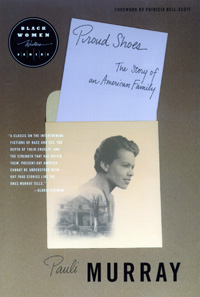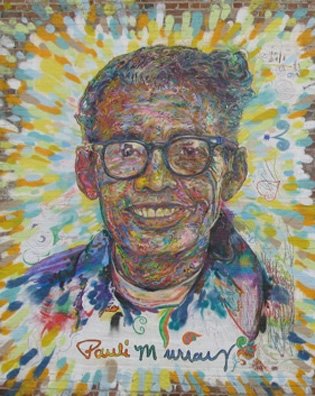By Paula Giddings

Shortly before her death, in 1985, Pauli Murray was scheduled to receive an honorary degree from her undergraduate alma mater, Hunter College, in New York City. She was 74 and too ill to appear in person, but managed to make a recording of her acceptance speech. When her thinned but resolute voice was played over the loudspeakers, those who knew of Murray’s life were not surprised at this latest demonstration of her extraordinary will — a will that propelled her to achieve more than her times, her color, or her gender prescribed. That life is eloquently reconstructed in Pauli Murray’s autobiography, one of the very few by a Black woman activist.
Graduation from Hunter in 1933 (as one of four Blacks in a group of 247 women) was, as she put it, her ”first successful milestone.” Reared in Durham, North Carolina, by an aunt, she had had to take an extra year of high school in New York City to meet Hunter’s entrance requirements. Once she got there she was forced to forgo so many meals to meet her expenses that she had to seek a doctor’s care for malnutrition. The physical frailty incurred during her school years would plague her for the rest of her life.
The path that yielded a law degree from Howard University, a master’s from the University of California’s law school, and a PhD from Yale was hardly a clear or straight one. In the 1930s, she found herself among the hobo community riding the frights in search of jobs. She worked for the WPA, the Harlem YWCA and Opportunity magazine. Her poems appeared in The Crisis and other publications, and she was encouraged by her literary association with the poet Stephen Vincent Benet to write the poignant family memoir Proud Shoes (Beacon Press).
She joined with the Workers Defense League in their unsuccessful attempt to save a Black sharecropper from execution for killing his white landlord, who had threatened and cheated him. In the 1940s, she came in second in a New York City Council race from Brooklyn’s 10th Senatorial District; she later taught at the Ghana Law School and at Brandeis.
Even more compelling than these palpable achievements is her political activism, which challenged the exclusion of Blacks and women before the issue became an acknowledged item on the national agenda. Murray fought for integration even before it was a goal of civil rights organizations like the National Association for the Advancement of Colored People (NAACP), which until the 19S0s concentrated on the “equal” of the separate-but-equal doctrine. In 1938, when the NAACP was bringing court cases showing the inequality of Black and white educational institutions, Murray applied to the all-white University of North Carolina at Chapel Hill. When she was rebuffed, she turned the application into a campaign, which probably hastened the entrance of the first Blacks there in 1951. Ironically, she also inadvertently abetted the development of the all-Black state school, then the North Carolina College for Negroes. “Every time Pauli writes a letter to the University of North Carolina,” commented a friend and editor of the Carolina Times, “they get a new building at the Negro college in Durham.”
In 1940, Murray and a friend refused to go to the back of a Virginia bus; they were arrested, jailed, and fined and became two of the earliest practitioners of the jail-no-bail strategy that would gain currency 20 years later. Her defiance, she wrote, also predated the period when “respectable people went to jail.” And while a student at Howard, she participated in the sit-in movement to desegregate Washington, D.C.’s restaurants and other public facilities, foreshadowing the mass movement of the 1960s.
It was at Howard, Murray writes, that she learned “to wage an effective struggle against Jim Crow.” It was also at that institution, the acknowledged leader in civil rights law, that she became conscious of sexism, or “Jane Crow” as she called it. As one of the few women law students there, she found herself the object not of hostility but of ridicule. On her first day of classes she was shocked to hear her professor announce, to the derisive laughter of the male students, that he didn’t know why women went to law school, but that since they were there, he guessed the men would have to put up with them. She responded with steely silence. “The professor didn’t know it,” she later wrote, “but he had just guaranteed that I would be the top student in his class. “He had also guaranteed that Murray would be a feminist pioneer as well as a civil rights activist. Upon her graduation from Howard with honors, she applied to Harvard Law School, which had yet to admit women. Another campaign ensued, which included a letter to Eleanor Roosevelt. (She already had a relationship with the First Lady, which had begun through correspondence, sometimes in angry tones about some injustice or Roosevelt’s own gradualist racial views—and developed into occasional invitations for lunch or tea at the White House.) Though Murray would again be rebuffed, she must have felt some satisfaction to learn that Franklin Roosevelt had been enjoined to write to the Harvard president on her behalf, and that the law faculty had split 7-7 on her application.
In the 1960s, Murray eagerly engaged in the budding feminist movement. She became a co-founder of the National Organization for Women, and co-wrote critical position papers on the ERA and Title VII of the 1964 Civil Rights Act. And she must have been doubly pleased to co-write the American Civil Liberties Union brief for the White v. Crook case, which successfully challenged all-white, all-male juries in Lowndes County, Alabama, and marked a turning point in civil rights law.
 But one senses that for her, the most significant campaign was the one she engaged in in her later years, for the inclusion of women in the Episcopalian priesthood. That went to the heart of Murray’s being. For beneath her drive, her will, her achievements, lay “the elusiveness of her self-esteem,” and the fact that she was “not entirely free from the prevalent idea that I must prove myself.” Perhaps, as Eleanor Holmes Norton suggests in her eloquent introduction to Song in a Weary Throat, it was being orphaned at an early age that made her feel she had to re-create her identity. Proud Shoes, which traced her multiracial family ties, was a product of that search, as her breaking down of barriers was an affirmation of self-worth. Her individualistic notions put her at variance with the Black nationalist students she encountered at Brandeis. Although she rightly criticized their excesses and sexist overtones, her breach with them was more fundamental. As she notes in her autobiography, she could not abide by their collective notion of blackness, especially as it was expressed through an ideology that would render ha own multiracial roots meaningless as a source of identity.
But one senses that for her, the most significant campaign was the one she engaged in in her later years, for the inclusion of women in the Episcopalian priesthood. That went to the heart of Murray’s being. For beneath her drive, her will, her achievements, lay “the elusiveness of her self-esteem,” and the fact that she was “not entirely free from the prevalent idea that I must prove myself.” Perhaps, as Eleanor Holmes Norton suggests in her eloquent introduction to Song in a Weary Throat, it was being orphaned at an early age that made her feel she had to re-create her identity. Proud Shoes, which traced her multiracial family ties, was a product of that search, as her breaking down of barriers was an affirmation of self-worth. Her individualistic notions put her at variance with the Black nationalist students she encountered at Brandeis. Although she rightly criticized their excesses and sexist overtones, her breach with them was more fundamental. As she notes in her autobiography, she could not abide by their collective notion of blackness, especially as it was expressed through an ideology that would render ha own multiracial roots meaningless as a source of identity.
Closely related to these feelings was the need to confirm her belief in her essential goodness, which may not have weathered her childhood experiences in a conservative middle-class community in the South. She was a spirited child who had the kind of personality that incited the close-knit community to assert its ultimate control: they characterized her not just as a child who misbehaved, but as deeply “bad.” This is borne out by her accounts of the humiliation she endured because of her mischievous conduct. After her high school commencement, for example, she was given a certificate for graduating at the top of her class, only to have it snatched away, in front of the whole assembly, by a teacher who had caught her throwing an eraser a few days before. For Murray, there could be no more powerful sanction of her goodness, of her identity in the oneness of God, than the priesthood. It is no wonder that when she was ordained in 1977, and performed her first Holy Eucharist in the same North Carolina chapel where her grandmother, a slave, had been baptized, she finally believed that “All of the strands of my life had come together. ”
—Profile by Paula Giddings, the author of When and Where I Enter: The Impact of Black Women on Race and Sex in America (Bantam). Review reprinted from The Nation May 23, 1987.
Related Resources
 Pauli Murray Center for History and Social Justice : Durham, North Carolina human rights project inspired by the life of Pauli Murray. Includes detailed biography, poetry, and traveling exhibit.
Pauli Murray Center for History and Social Justice : Durham, North Carolina human rights project inspired by the life of Pauli Murray. Includes detailed biography, poetry, and traveling exhibit.










I am grateful that she shared with me in the ministry of Jesus at The Episcopal Church of the Atonement, Washington, D.C. It was a blessing to walk beside her “proud shoes.” — Robert B. Hunter
I recently discovered a few of Paul Murray’s good poems in the early 1960’s anthology, American Negro Poetry. Happy I am to have her extraordinary life written out here. She remains clearly special.